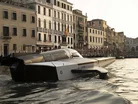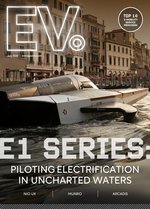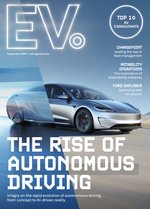E1 Series: Piloting electrification in uncharted waters

Disruption to the environment is an imminent threat to our livelihoods on this planet, which we know is recognised by businesses and consumers. In fact, it’s the most prominent conversation across all forms of industry, media, and in governments.
This is because climate change affects all. The state of the climate impacts business and vice versa. One of the more pressing matters to enter into the light over the past couple of decades is the cycle of consumption that is affecting our oceans.
Ocean life is at risk as a result of the rising atmospheric temperatures after having absorbed roughly 90% of all excess heat generated by emissions. But, if this vastly uncharted ecosystem were to be kept alive, the positive impacts would be tremendous. Today, the ocean’s resources and seascape are also impacted by the rising tides, increased disruption from water craft, and the pollution from microplastics and other disposable items.
These are the issues that water crafters witness on a regular basis, particularly Rodi Basso, the Co-Founder and CEO of the UIM E1 Series World Championship. For those who are not quite familiar with the marine industry or are unaware of what the E1 Series is all about, the story begins with SeaBird Technologies.
Well-acquainted with the Founder, Chairman & Head of Design at Seabird Technologies, Sophi Horne, Basso was inspired by his experience as the CTO for the company – alongside his passion for the ocean environment – to take action in such a way that would not only bring awareness of climate change issues, but build excitement around solving them.
“When I go sailing, I feel the impact. I can see, very concretely, the impact of the changes, and the way the climate is behaving is completely different compared to what I used to experience 20 or 30 years ago,” says Basso.
“Now, there are sudden changes in weather conditions; tropical behaviour in areas that are not. There is something that has changed.”
Working alongside Basso and the team, SeaBird Technologies brought to life the design idea pioneered by Horne herself, which led to the birth of the electrified boat – the RaceBird.
With the design already on the page, one of the main pieces of the puzzle was already in place – Basso entered discussions with Alejandro Agag, Founder & CEO of Extreme E and Founder & Chairman of Formula E & E1 Series, to formalise the race as a sustainable initiative that will revolutionise the way the world views powerboating.
The name E1 Series was soon created to represent the motorsport in its entirety, highlighting the electrified component of the championship with ‘E’, with the ‘1’ confirming its pioneering status. Having shared the journey from concept to reality via the E1 Series YouTube channel, the teams very quickly brought SeaBird’s vehicle to fruition. The next step anticipated by the company, and its expected hoard of spectators, is bringing the championship to life – in the name of technology and sustainability.
During the process, the team was challenged with a number of variables like any others that could be expected in the road racing world, which really suggest just how powerful and complex the ocean setting can be.
“Developing this technology is not easy. It was easy to underestimate. When you’re on the edge of foiling – the speeds that you can achieve, an electric powertrain – and you’ve got the race design of the boat, you’re looking to combine all these aspects and make it really interesting to watch,” says Richard Draisey, CEO of SeaBird Technologies.
“Plus, the sea isn't like the road. The sea moves all the time, and there's another real consideration. How do we account for that? How do we keep it interesting? How do we mitigate any of the sea state or the running conditions?”
The team is effectively attempting to design, build, and optimise a machine for an ever-changing – one that is less predictable than any other and certainly not for the fainthearted. Perhaps this is another reason why the operators are titled pilots: to better reflect the challenge they will undertake.
Engaging sustainability-conscious people with a racing spectacle
Of course there will be excitement, fun, and atmosphere at each racing venue, but a major portion of the championship’s impact is reserved for the coastal areas – their environments as well as their economies.
The legacy projects of the E1 Series are well underway, supported by expert marine biologist Carlos Duarte who encourages a necessary outlook on the current marine environment of each host city, but also supports long-standing projects with results remaining long after the season closes.
“Carlos Duarte involved two global universities to assess our impact, including emissions, noise, and also wave generation, because there are some places in the world that are very much affected by the wave generation of boats,” says Basso.
“This has an impact on coastal erosion. So, we are waiting for the result of this assessment carried out over the past month. We will know more and be able to improve as we go.”
From a commercial perspective, E1 Series is committed to the support of those local to its racing venues, which is also a major component of its legacy initiative that will incorporate local talent and businesses in making the events happen. Attracting people to the races, Basso and the team hope to boost the local economic activities in these areas and create awareness around projects that can be executed to protect local marine life.
Beyond the work taking place on the ground, influence comes as a double-edged sword, with one pointing towards area development while the other creates an influx of awareness within the boating industry, attracting new talent and encouraging innovation in the water craft sector.
“I'm really excited to see, as we launch the championship; to see how we can get people excited about boats, because I think there's a massive opportunity that's not being taken advantage of,” says Draisey.
“We've got a real differentiator there in association with E1, and we’re in a fortunate position where we are able to provide that product and develop it with Rodi and his needs. And, in terms of hiring people, it makes my job super easy to say ‘come and do some exciting engineering on this product’.”
When race day comes, it will be an exciting one for a multitude of reasons. It will confirm the research and development of the RaceBird as a high-performance electrified boat. E1 Series will also engage the public in events that bring awareness to the ocean and how to protect it through continued action and industry evolution, and the teams will also enable local people to get involved in sustainable action and promote businesses and their sustainable impacts.
But the progress will not end there, as Basso explains the trajectory that he hopes to follow while the UIM E1 Series World Championship grows over the next five years.
“Our vision is to have a very rich, international calendar in five years. So, our target is 15 to, maybe, 18 races across the world, starting with The Middle East and Europe,” says Basso.
“These are areas of the world that have been attached more in the past year and a half. But, in parallel, we’ve already had existing conversations and interests elsewhere in the north of South America, as well as Singapore, Sydney, Indonesia, and so forth.”
Although both SeaBird Technologies and E1 Series have great ambitions for zero-emission business and ocean decarbonisation, it’s become clear there are a number of factors that can be influenced in the making and racing of electric boats. These range from education to innovation.
“We have to make sure that, whenever we show up, the event is self-sustainable from an energy standpoint. If we are not, we will make sure that we will be at least carbon neutral,” says Basso.
Draisey also says: “ There’s always improvements to be made, but I think it’s very easy to sit back, criticise, and not actually take action, which is what we really want to push at SeaBird.
“At SeaBird, we’re looking into our next product and how we can design something that has the minimum holistic impact on the environment – from build to disposal.”
- More Than Half of UK Drivers are Ready to Go ElectricCharging & Infrastructure
- ABB's Electrification Testing & Formula E PartnershipSustainability
- Fleet and energy supply chain: all zero-emission & electricFleet & Commercial
- The year’s EV executive shifts driving electrificationTechnology




